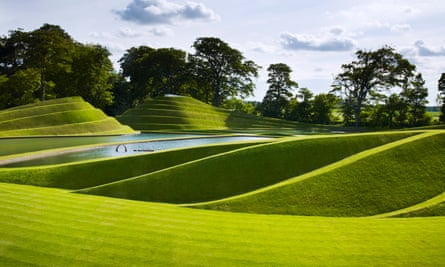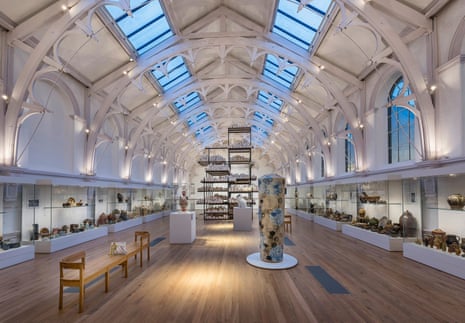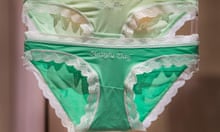Tracy Chevalier on York Art Gallery
I was writer in residence at the gallery in 2008 and so knew it in its old incarnation as well as its new, following the superb renovation last year. It remains a very democratic experience. York Art Gallery has always been welcoming, with lots of places to sit and ways to interact with the collection that are not naff, most notably being able to handle some of the ceramics. A domestic-style space in which to view the ceramics collection donated by Anthony Shaw in their natural setting encourages this interaction. And there are now even more signs saying “hands on” rather than “hands off”, including on a Jacob Epstein bust of Paul Robeson.
Everyone wants to touch art, especially ceramics, and the gallery has taken an executive decision that things in the handling collection will get broken occasionally (although now they have put a carpet down they bounce more often than not). The result is a sense of boundaries breaking down, and you stop just passively going from exhibit to exhibit. You really do believe it is your place.
The biggest change is in the building itself and what that has allowed the museum to do with its collection. The skylights in the high-ceilinged Victorian central hall were boarded up in the 1960s. By opening them up, and creating a new mezzanine level, the gallery has created a spectacular new space that is showered in daylight. Ceramics can withstand natural light, unlike painting and other art works that have to be preserved in dimmer rooms.
In the new space, form and function go hand in hand. The new floor is now the focal point of the Centre of Ceramic Art, which houses the world’s most representative collection of British Studio ceramics. The great names are all there, from Lucie Rie and Ian Godfrey up to Elizabeth Fritsch, Edmund de Waal and Grayson Perry, and the gallery has been very clever to make so much of this work. The cliche of a provincial art gallery is of mostly mediocre art with one or two star pieces, usually paintings. York has ignored the cliches. It has declared itself the home of a world class ceramics collection and now has a building fit to display it.
Grayson Perry on Bethlem Museum of the Mind, Beckenham, Kent

The museum is situated in an art deco building in the grounds of the Bethlem Royal Hospital, the UK’s oldest psychiatric institution, which was founded in 1247 and is now in Beckenham. As you go in you see the original large stone gatepost sculptures that graced the entrance of Hogarth’s Bedlam when he depicted people on Sunday afternoon tours to stare at the lunatics. The museum today holds the collection of art made by people who have been in the hospital over the centuries. Probably the most famous artist is the 19th-century painter Richard Dadd, who was committed after murdering his father. His visionary art is mind bogglingly detailed fairy fantasy, the most psychotically detailed thing you’ll ever see. You need a magnifying glass to look at them properly and they provide an extraordinary glimpse into his mind.
These days there is a fascination with what is called “outsider art”, work by people who haven’t been to art school. There is a particular quality in the work of many of the artists here – you can see something of their soul, yet the work is not self-consciously allied with art history.
I was asked to re-open the renovated space last year and toured the whole facility, including the secure units in the hospital and so on, which was both fascinating and sobering. There are workshops and well-equipped art studios for the current patients, and a space in the museum for them to exhibit – and sell – their work. I empathise with artists who have mental health issues as I have a fair dose of detail, drive and obsessiveness myself. So the museum illustrates a principle that I hold very dear; that those who get the most from art are the people who make it. There are certainly clear mental health benefits involved, not just from expressing yourself but also from the therapeutic activity of actually doing it.
I’ve met several people who’ve been patients in the hospital and they talk warmly about their experiences of making art as part of their treatment. It is such a healthy sign that today we are more likely to speak about mental health than we were a few decades ago. The Bethlem Museum of the Mind contributes to this not only in helping us learn about mental health care, but in providing a space for the essential human processes of self-exploration and communication.
Grayson Perry: All Man begins on Thursday at 10pm on Channel 4.
Norman Foster on Victoria and Albert Museum, London

The V&A has always been a particularly important institution for me. Its beginnings, coming out of the Great Exhibition of 1851, were genuinely radical and it is has stayed true to them, despite acquiring more than a whiff of the establishment over the years. It has done this by maintaining its links to its roots – and its rigorous curatorial standards – while adapting to the modern day. Its ability to continually reinvent itself has come with a consistent capacity to surprise. Who would have anticipated it attracting half a million visitors to the Alexander McQueen exhibition? But anything is possible in a place that can span from Raphael to fabrics to propellers and works of engineering. It really is an emporium of everything inspirational.
I first visited as a student from Manchester coming down to London some time in the late 50s. The scale of the place seemed to echo the scale of the metropolis itself. There was an element of awe – it was like a city in microcosm where you could wander around and get wonderfully lost. All these years later it still has the power to impress and to provoke genuine joy. I was there on a Friday evening recently and the place was absolutely swinging.
When the V&A’s 150th anniversary came round a few years ago I pondered on the nice ambiguities in the word “museum”. It takes in the Greek and Roman idea of the muse as source of the artist’s inspiration as well as the French “muser” – to meditate or waste time. In that sense the V&A is the perfect museum: a treasury of artifacts and ideas. What better place could there possibly be to seek inspiration or simply idle away an afternoon?
Antony Gormley on Jupiter Artland, West Lothian

In 1999 Robert and Nicky Wilson took on a fading Jacobean manor house between Edinburgh and the Pentland Hills. They soon turned a building that was fading both in material terms and in its cultural relevance into a place of engagement, immersion, healing and sharing. In what is an enormously generous act, they have combined faith in human creativity and belief in the power of nature to make a new kind of creative space.
It is extraordinary that in a dozen or so years, that apparently anachronistic model of house, grounds and lakes has been revitalised: it has now welcomed nearly 200,000 visitors, not simply to share the spaces and works of contemporary art but also to encourage creativity. Many of the visitors have been school children, who can not only look at the art, but also engage, make and touch, learning new ways to express thought and feeling.
Jupiter extends the rich British tradition of landscape as cultural proposition. The Wilsons commissioned Charles Jencks to make landforms that question our relationship to geology and to our own imagining. They brought and commissioned work by artists such as Ian Hamilton Finlay, Anish Kapoor, Cornelia Parker and Andy Goldsworthy but at the same time initiated new attitudes to the way art can be seen. They offer younger, emergent artists such as Tara Donovan, Sara Baker and Edwin Burdis the opportunity, often for the first time, to work outdoors, and to make new pieces and to respond to the place, and to a context which is, in effect, a history of contemporary practice.
Jupiter is digitally impressive and smart. The physical experience in time and in weather is complemented by a website that takes the integration of work and place to the wider world. It is less a sculpture park than a workshop and laboratory, where new things that have not been made before come into dialogue with things that already exist, allowing them to grow in people’s minds and imaginations as well as in weather and season.
I have found on my visits that there is always something new to see, always some new provocation to extend my experience and think about human futures. The openness of this young institution to new visitors, new thoughts, new feelings and new art make it one of the most precious and vital organs of creativity within these lands.
John Akomfrah on Arnolfini, Bristol

I’m part of the generation that knew the Arnolfini in the 80s. Bristol had this incredible energy and a lot of it crystalised around the gallery. If you were in the city to watch bands or see shows then the Arnolfini was a Friday night watering hole, a refuge and the place you had to be to find out what was going on. It seemed tied up with the excitement of bands such the Pop Group, Rip, Rig + Panic and then Massive Attack. Almost inevitably, as the 90s went into the 00s, there was a sense that the venue had slightly lost that centrality; these things always move on. Which makes it all the more pleasing, and impressive, that in recent years the Arnolfini has again found its voice and place, and a new distinctiveness that chimes with people.
It has done this by keeping true to its roots – it was founded in 1961 – as one of the earliest interdisciplinary contemporary arts venues, presenting programmes of performance, dance, film and music alongside visual art. Last year it pulled off a significant coup in staging a large exhibition by Richard Long. It was a fine illustration of the level of its ambition as well as its capacity to successfully carry off big projects. The director, Kate Brindley, approached me about hosting the UK premiere of my video installation Vertigo Sea. That she came to me before the work had received any press, in effect before any critical consensus had gathered around it, impressed me. She really stuck her neck out and that sort of decisiveness and commitment, just being a bit ahead of things, has marked the Arnolfini out in recent years. The gallery then followed through in terms of execution and I was blown away by the quality of the installation. It is the best I’ve seen, and that includes the Venice Bienalle.
When the gallery moved in 1975 to its present home, a converted warehouse in the docks area, it was a trailblazer for a movement that has become the norm for cultural transformations of formerly rundown inner city areas. Its example was followed by Tate Liverpool, the Sage Gateshead and many other institutions. Back then the Arnolfini felt ahead of its time, so it is wonderful to see that it has found that role again; a home for ideas and work before they become orthodoxies.









Comments (…)
Sign in or create your Guardian account to join the discussion